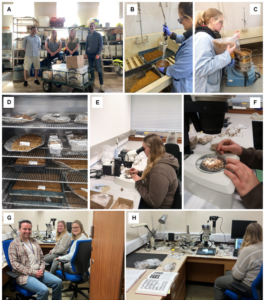Partnership seed-funded project: Unlocking NHM field samples for fossil vertebrates: a pilot project
In 2024 a pilot project to process NHM palaeontological field samples in the Quaternary Scientific (QUEST) labs at UoR was undertaken by Juliette Kent (QUEST Professional Placement student), with guidance from Neil Adams, Curator of Fossil Mammals at the NHM, and Hester Crothers and Rob Batchelor, QUEST Geoarchaeological Technician and Director.
Westbury Cave in Somerset was chosen as the source of selected samples as they have excellent potential to address unanswered research questions relating to their age through micromammal biochronology—the dating of fossil sites by identifying small mammal species with known geological timespans in the fossil record.
78kg of NHM samples from Westbury Cave were wet-sieved, graded, and washed, and a resulting 25kg of sample residues were sorted for microvertebrate fossils in broad categories (e.g., vole molars, rodent incisors, postcranial bones, etc). Neil provided Juliette and Hester with basic training in photomicroscopy for the imaging of small mammal fossils and in taxonomic identifications.
 Preliminary identifications of the fossils revealed specimens of national importance, especially those of the vole Allophaiomys, an extinct grassland vole with rootless molars; these are only the third and fourth specimens of this genus known in the British fossil record. Another star specimen is the most complete specimen of Mimomys (an archaic water vole) known from Westbury Cave: a left upper first molar preserved inside an upper jaw fragment. Voles are crucial for the biochronology of the Pleistocene Ice Ages across Europe, and specimens such as these help researchers to test the age of these sediments and to better understand the nature of the mammal fauna during a poorly sampled interval in the British fossil record.
Preliminary identifications of the fossils revealed specimens of national importance, especially those of the vole Allophaiomys, an extinct grassland vole with rootless molars; these are only the third and fourth specimens of this genus known in the British fossil record. Another star specimen is the most complete specimen of Mimomys (an archaic water vole) known from Westbury Cave: a left upper first molar preserved inside an upper jaw fragment. Voles are crucial for the biochronology of the Pleistocene Ice Ages across Europe, and specimens such as these help researchers to test the age of these sediments and to better understand the nature of the mammal fauna during a poorly sampled interval in the British fossil record.
Other important specimens are the first recorded teeth of the Leporidae (the family including rabbits and hares) from this unit in the cave (Fig. 5F–G), with their relatively large size suggestive of hares in the genus Lepus. All these specimens will be included in upcoming research on the micromammal biochronology of the Siliceous Member led by Neil and will be registered into the NHM fossil mammal collection.
Photos of activities undertaken during the project. (A) NHM samples and project consumables being delivered to the Quest labs at UoR in September 2024. (B) Samples being washed through a sieve. (C) Sieved sample residues being graded through nested sieves to produce size fractions for sorting. (D) Wet-sieved samples drying. (E–F) Samples being sorted for microvertebrate and other fossil remains such as invertebrates and plants. (G–H) Finds being examined, photographed and assigned preliminary identifications at the NHM in December 2024.
This kind of project supports work on the correlations and ages of the units across UK cave systems, with important implications for faunal turnover and mammalian adaptation to climate changes around 500,000 years ago. A sub-site of Westbury Cave has produced cut-marked bones which show early human presence, and unidentifiable bone fragments from this area were found during this project. These could be used in future studies with state-of-the-art methods to test if any of them came from bones of early humans.
As an outcome of this study, Neil and Rob have instituted an undergraduate practical class at UoR as part of the second-year module in Palaeobiology, which will provide valuable experience for students and enable up to 150 hours of additional residue sorting. Outreach activities and potential student dissertation projects are also planned, alongside future grant applications for further research.
Placement student Juliette notes, “This experience has been beneficial in developing my knowledge and practical skills in processing and sorting field samples correctly. I enjoyed the whole experience and felt that I was well instructed and supported by both organisations throughout the project”.
Seed-Funding is available to support the development of collaborative projects to be undertaken by researchers at the University of Reading and the Natural History Museum.
Featured image at top: Finds from residue sorting. (A) All finds made during the project. (B) Bone fragments that could be used for new techniques, such as ZooMS, proteomics and aDNA

